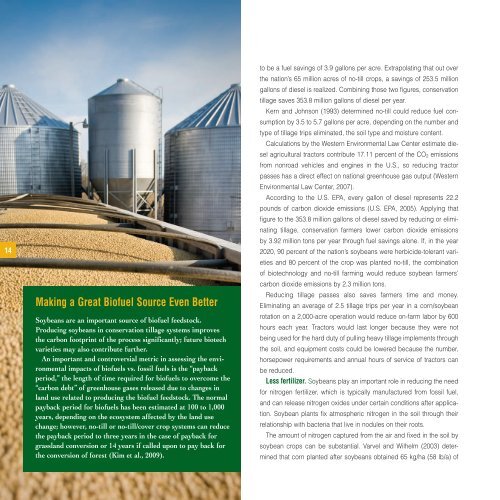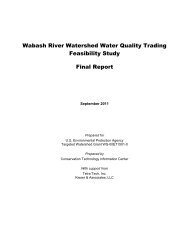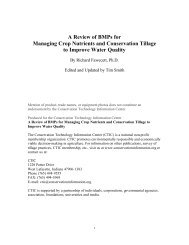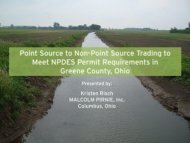Facilitating Conservation Farming Practices and Enhancing ...
Facilitating Conservation Farming Practices and Enhancing ...
Facilitating Conservation Farming Practices and Enhancing ...
You also want an ePaper? Increase the reach of your titles
YUMPU automatically turns print PDFs into web optimized ePapers that Google loves.
14<br />
Making a Great Biofuel Source Even Better<br />
Soybeans are an important source of biofuel feedstock.<br />
Producing soybeans in conservation tillage systems improves<br />
the carbon footprint of the process significantly; future biotech<br />
varieties may also contribute further.<br />
An important <strong>and</strong> controversial metric in assessing the environmental<br />
impacts of biofuels vs. fossil fuels is the “payback<br />
period,” the length of time required for biofuels to overcome the<br />
“carbon debt” of greenhouse gases released due to changes in<br />
l<strong>and</strong> use related to producing the biofuel feedstock. The normal<br />
payback period for biofuels has been estimated at 100 to 1,000<br />
years, depending on the ecosystem affected by the l<strong>and</strong> use<br />
change; however, no-till or no-till/cover crop systems can reduce<br />
the payback period to three years in the case of payback for<br />
grassl<strong>and</strong> conversion or 14 years if called upon to pay back for<br />
the conversion of forest (Kim et al., 2009).<br />
to be a fuel savings of 3.9 gallons per acre. Extrapolating that out over<br />
the nation’s 65 million acres of no-till crops, a savings of 253.5 million<br />
gallons of diesel is realized. Combining those two figures, conservation<br />
tillage saves 353.8 million gallons of diesel per year.<br />
Kern <strong>and</strong> Johnson (1993) determined no-till could reduce fuel consumption<br />
by 3.5 to 5.7 gallons per acre, depending on the number <strong>and</strong><br />
type of tillage trips eliminated, the soil type <strong>and</strong> moisture content.<br />
Calculations by the Western Environmental Law Center estimate diesel<br />
agricultural tractors contribute 17.11 percent of the CO 2 emissions<br />
from nonroad vehicles <strong>and</strong> engines in the U.S., so reducing tractor<br />
passes has a direct effect on national greenhouse gas output (Western<br />
Environmental Law Center, 2007).<br />
According to the U.S. EPA, every gallon of diesel represents 22.2<br />
pounds of carbon dioxide emissions (U.S. EPA, 2005). Applying that<br />
figure to the 353.8 million gallons of diesel saved by reducing or eliminating<br />
tillage, conservation farmers lower carbon dioxide emissions<br />
by 3.92 million tons per year through fuel savings alone. If, in the year<br />
2020, 90 percent of the nation’s soybeans were herbicide-tolerant varieties<br />
<strong>and</strong> 80 percent of the crop was planted no-till, the combination<br />
of biotechnology <strong>and</strong> no-till farming would reduce soybean farmers’<br />
carbon dioxide emissions by 2.3 million tons.<br />
Reducing tillage passes also saves farmers time <strong>and</strong> money.<br />
Eliminating an average of 2.5 tillage trips per year in a corn/soybean<br />
rotation on a 2,000-acre operation would reduce on-farm labor by 600<br />
hours each year. Tractors would last longer because they were not<br />
being used for the hard duty of pulling heavy tillage implements through<br />
the soil, <strong>and</strong> equipment costs could be lowered because the number,<br />
horsepower requirements <strong>and</strong> annual hours of service of tractors can<br />
be reduced.<br />
Less fertilizer. Soybeans play an important role in reducing the need<br />
for nitrogen fertilizer, which is typically manufactured from fossil fuel,<br />
<strong>and</strong> can release nitrogen oxides under certain conditions after application.<br />
Soybean plants fix atmospheric nitrogen in the soil through their<br />
relationship with bacteria that live in nodules on their roots.<br />
The amount of nitrogen captured from the air <strong>and</strong> fixed in the soil by<br />
soybean crops can be substantial. Varvel <strong>and</strong> Wilhelm (2003) determined<br />
that corn planted after soybeans obtained 65 kg/ha (58 lb/a) of








